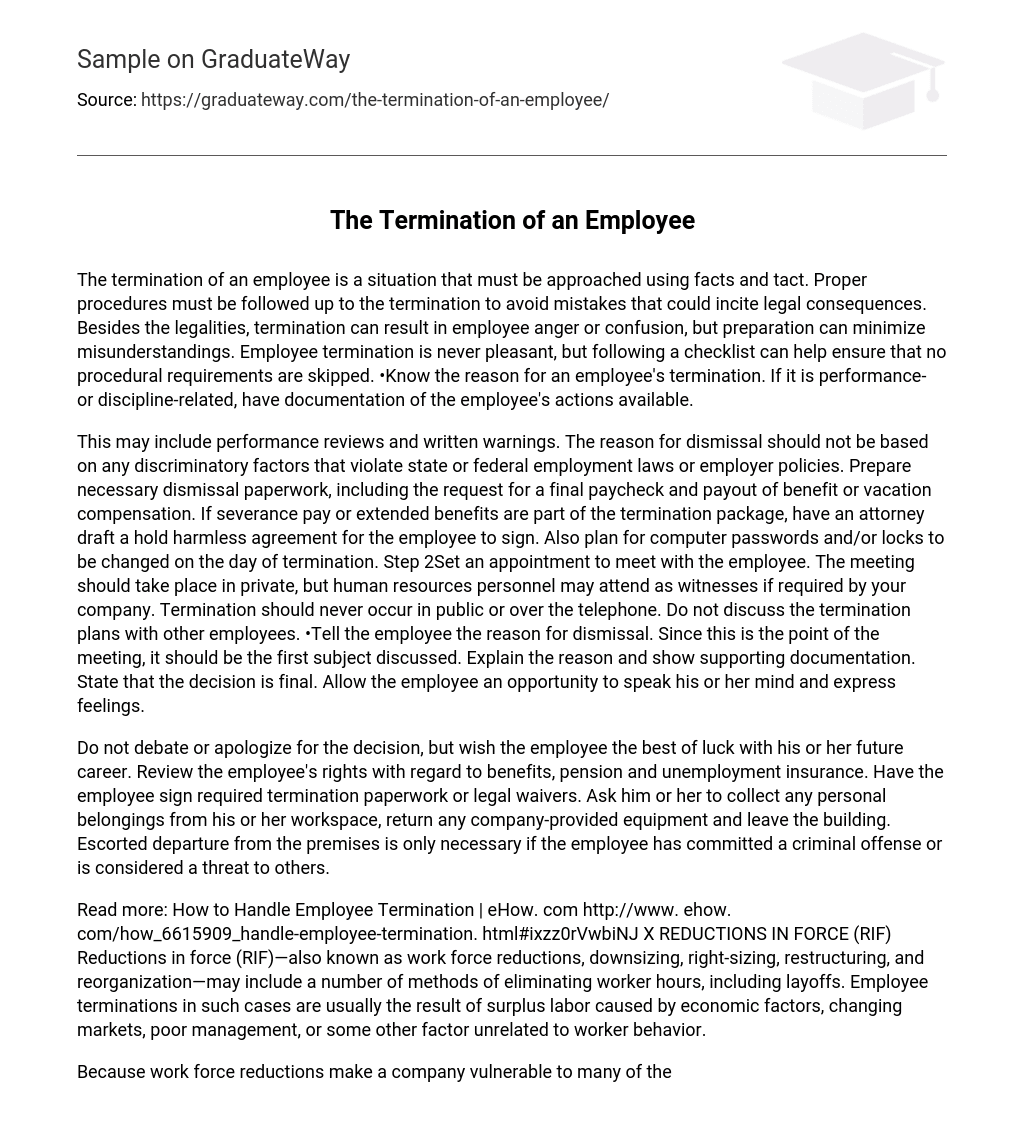The termination of an employee is a situation that must be approached using facts and tact. Proper procedures must be followed up to the termination to avoid mistakes that could incite legal consequences. Besides the legalities, termination can result in employee anger or confusion, but preparation can minimize misunderstandings. Employee termination is never pleasant, but following a checklist can help ensure that no procedural requirements are skipped. •Know the reason for an employee’s termination. If it is performance- or discipline-related, have documentation of the employee’s actions available.
This may include performance reviews and written warnings. The reason for dismissal should not be based on any discriminatory factors that violate state or federal employment laws or employer policies. Prepare necessary dismissal paperwork, including the request for a final paycheck and payout of benefit or vacation compensation. If severance pay or extended benefits are part of the termination package, have an attorney draft a hold harmless agreement for the employee to sign. Also plan for computer passwords and/or locks to be changed on the day of termination. Step 2Set an appointment to meet with the employee. The meeting should take place in private, but human resources personnel may attend as witnesses if required by your company. Termination should never occur in public or over the telephone. Do not discuss the termination plans with other employees. •Tell the employee the reason for dismissal. Since this is the point of the meeting, it should be the first subject discussed. Explain the reason and show supporting documentation. State that the decision is final. Allow the employee an opportunity to speak his or her mind and express feelings.
Do not debate or apologize for the decision, but wish the employee the best of luck with his or her future career. Review the employee’s rights with regard to benefits, pension and unemployment insurance. Have the employee sign required termination paperwork or legal waivers. Ask him or her to collect any personal belongings from his or her workspace, return any company-provided equipment and leave the building. Escorted departure from the premises is only necessary if the employee has committed a criminal offense or is considered a threat to others.
Read more: How to Handle Employee Termination | eHow. com http://www. ehow. com/how_6615909_handle-employee-termination. html#ixzz0rVwbiNJ X REDUCTIONS IN FORCE (RIF) Reductions in force (RIF)—also known as work force reductions, downsizing, right-sizing, restructuring, and reorganization—may include a number of methods of eliminating worker hours, including layoffs. Employee terminations in such cases are usually the result of surplus labor caused by economic factors, changing markets, poor management, or some other factor unrelated to worker behavior.
Because work force reductions make a company vulnerable to many of the same legal risks inherent in behavior-related terminations, companies usually terminate workers by means of a carefully planned and documented process. The process is typically conducted in two stages: 1) selecting the workers to be dismissed and then terminating them according to the above process; and 2) providing benefits to ease the transition, including severance packages, unemployment compensation, and outplacement services.
Selecting and terminating employees is handled carefully because most profit-maximizing organizations are obviously concerned about losing talent or diluting the effectiveness of the company. But care must also be taken to ensure that the reductions do not violate state and federal laws. As with behavior-related terminations, downsizing terminations cannot be based on bias against protected minorities, or even unintentionally result in an inequitable outcome for a protected group.
In fact, extensive legislation exists to protect disabled workers, racial minorities, workers over the age of forty, women, and other groups. In addition to bias-related laws, moreover, companies must comply with a battery of laws specifically directed at corporate layoffs. For example, the federal Worker Adjustment and Retraining Notification (WARN) Act of 1988 requires companies with 100 or more employees to file at least sixty days prior notice before conducting mass layoffs or work force reductions.
Among other stipulations, the notice must be in writing and addressed to employees and specified government workers. The second stage of the downsizing process, outplacement, is also heavily influenced by legislation aimed at protecting employees. But it is also used to maintain the morale of the work force and to enhance the public image of the company conducting the work force reduction. Outplacement usually includes two activities: counseling and job search assistance. Counseling occurs on both the individual and group levels.
Both are necessary to help the displaced worker 1) develop a positive attitude; 2) correctly assess career potential and direction, including background and skills, personality traits, financial requirements, geographic constraints, and aspirations; 3) develop job search skills, such as resume writing, interviewing, networking, and negotiating; and 4) adjust to life in transition or with a new employer. Many companies assist with the job search by hiring a job-search firm to help their terminated employees find new work.
In addition to providing some or all of the counseling services described above, job-search companies act as brokers, bringing together job hunters and companies looking for employees. Job-search companies can expedite the job hunting process by eliminating mismatches from the interview process and by helping both parties to negotiate employment terms. In some cases, the former employer will reimburse job hunting costs as part of the severance package of benefits http://definitions. uslegal. com/e/employee-termination/





